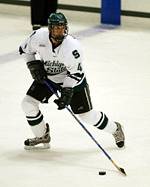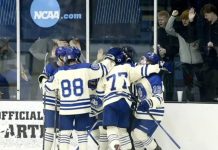Let’s revisit the controversial no-goal in Friday night’s game between Michigan and Michigan State at Munn Ice Arena.
Several people are culpable of errors, myself included.
I’ll walk you through this as I watch our coverage of this in-game controversy on CSTV last Friday.
First, let me get on me. Here is where I blew it. The up-top view we saw on CSTV was from what is called a POV (point of view) camera located on the glass above the goal judge. From that angle, and every other one, there is no question that Ethan Graham’s bomb from the left faceoff dot was a goal.

His shot beat Michigan goalie Billy Sauer clean above his left shoulder. The puck went through a hole in the net and bulged the twine outward. No question from any angle we saw, as producer Ross Molloy gave viewers every angle, multiple times.
I did mention that referee Steve McInchak only gets one view, from above on a camera provided by the CCHA, not CSTV. The official word is that with the technology provided and the replay that they were privy to, there was no conclusive evidence that the puck went through the net. I did not mention, nor did we show a replay from directly above as we did not have an overhead POV.
Therefore, CSTV did not show viewers the exact replay McInchak saw. I should have brought that up, I didn’t. I also said “when this all over, it will be 2-0 Michigan State.” It wasn’t. It should have been.
Here is where others are at fault. We can put a man on the moon and transplant a heart to save a life. How is it that we don’t have the technology to shoot a goal net 50 feet below a mounted camera that can present a clear picture and confirm what the naked eye suspected at full speed? We mentioned it after the play, and McInchak must have suspected it because he called for review, and I suspect that was aided by a hand signal that Michigan State head coach Rick Comley immediately made to McInchak.
Here is where I blame the powers that be in this and all conferences. The CCHA has review in three buildings, Lawson (Western Michigan). Yost (Michigan), and Munn (Michigan State). The only view the referee can use is the one from the CCHA camera. In this case, the camera lied — well, actually, it just didn’t tell the truth.
CSTV showed that replay of the bulging twine and puck passing through many times (I felt like I was watching the Zapruder film clip of the Kennedy assassination trial in the film JFK: “back and to the left”).
My question is this? Why can’t the referee, who is trusted to officiate the game to the best of his ability by the conference that has hired him, use the most advanced technology and evidence available to make the proper call?
Michigan State, like every team in the conference, is battling for points. They could have had two, and Michigan none on Friday night if McInchak had been allowed to use our replays. Instead, he looks bad because he made a call everyone in two countries watching the game knows was wrong. To make matters worse, I’m all over him because of it, which I wasn’t happy doing because I think he’s a very good ref. (He was also doing his fourth game in eight days, including last Friday and Saturday in Alaska, the previous Tuesday at Munn for MSU and Ferris State).
The argument is that it would not be fair to the teams that are not televised as much. Michigan will be on TV a record 22 times this season, that can’t be said for Lake Superior State. If Lake State had scored a goal like that in a non-televised game, and the overhead (when they get one next season) was inconclusive like it was at Munn, LSSU wouldn’t have an opportunity to have the referee see a better view.
OK, I get the point. I just do not agree with it.
A lot of rinks (Qwest Center at UNO comes to mind) shoot the game (and record it) to show it on the Jumbotron, complete with replays from different angles and post-game melts (a television term that refers to a special broadcast-quality tape with game highlights. When you see a TV network show in-game video or video to tease a game, it usually comes off the melt).
Officials could have access to better technology, and different angles.
Tom Anastos, the CCHA commissioner, has no bigger fan than me. I don’t always agree with him (like on this issue), but respect the fact that he is willing to think outside the box, go after what he believes will make college hockey better, and put his reputation on the line for the sake of the game.
That said, I believe that the time has come to shore up this area to make sure teams don’t get the short end of a bad call that was easily correctable. I can’t speak for McInchak, but I’d believe he would have loved to see CSTV’s replays. Both coaches saw it, and both said on the record to various media outlets that CSTV replays showed that the puck went in.
Comley and Michigan head coach Red Berenson are two of the game’s ultimate professionals, and neither laid blame with the league or the referee for the non-goal call. Class acts, both of them.
However, both would probably say that that point earned by Michigan with the 1-1 tie (helped a bit by the momentum swing and the lengthy delay that took the energy out of the crowd and the Spartans for a good while), and the point lost by the Spartans and the chance to pull three ahead of Michigan with a win will be factors when the final bell rings on the regular season.
That brings me to another Michigan goal/no-goal incident, on November 4 in South Bend. Michigan actually scored a goal with the net dislodged behind David Brown. It was off the post by a about a foot, and was dislodged a few seconds before the puck went in. One assistant and the referee saw the net off and never blew the whistle. The goal stood even after they chatted about it. One look at Mr. Molloy’s replays and conclusive evidence would have shown that the goal never should have counted.
My point is this. Get the CCHA coaches together in Naples, Fla., in April at the annual convention. This group proved to me last September in Detroit that it has no problem hanging out, having a good time, and discussing ideas that would make the game better. I like this group of coaches. Their passion for their conference is obvious, and the same should be said for Anastos, himself a former standout player at Michigan State.
At that chat, whether at the pool, on the links, or in the hotel lobby, get every coach to agree that any goal (or potential goal) can be reviewed by the referee using the best means available on that evening. Allow the video coordinator that night to be allowed to show him every angle. The decision of the referee will be final: he gets to make the call, and gets the opportunity to convince himself, beyond a doubt, that it is the right one.
What about replays that are conclusive from one angle, and inconclusive from another? Prioritize your angles, and have the TV producers that cover your conference involved in the discussion (I’d be thrilled to sit in on this one). They can look at your building surveys and explain where they’d be able to get camera angles, and where the teams can have cameras to shoot the game.
Overhead could be the No. 1 look. If inconclusive, or if the view is obstructed by crease congestion, the POV behind the net could be No. 2, corner handhelds, game or tight cameras, slash cameras, whatever.
This issue is solvable, and needs to be fixed prior to next season. For the good of the games in the CCHA, let’s get it done.


